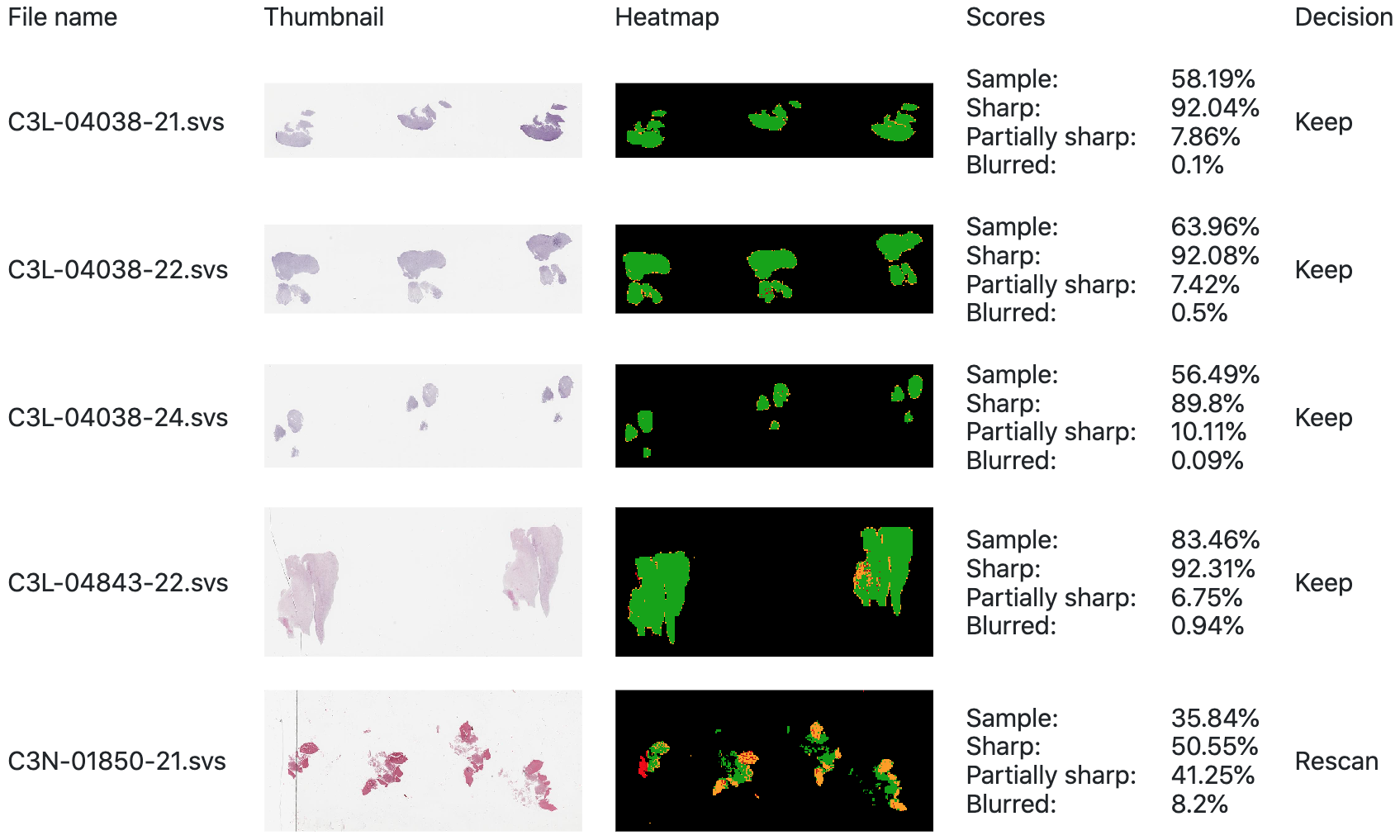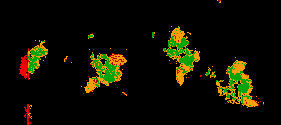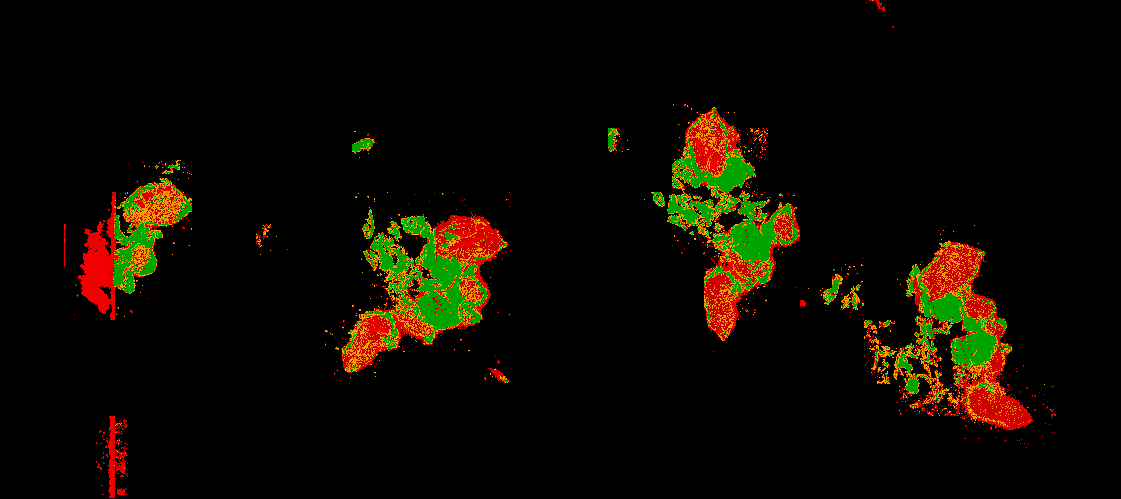Any Kind of Image
315+ formats, read through imaging libraries (opencv, openslide, dicom, etc.), or served through image tile servers (bioformats, google maps, etc.)
Pathology image digitization and visualization are constantly improving.
However, studies show that around 10% of images must be reacquired at least once and image quality is – to this day – still assessed visually by a specialist.
magIQ automatically analyzes images with unique speed and precision, for continuous improvement in image quality and quality of care.
magIQ opens more than 315 image formats, browses through every available magnification level and all regions of an image, without missing a thing.
magIQ analyzes images through multiple parameters and provides, for each parameter, normalized numerical scores: Sample detection, focus, hue, saturation, brightness, etc.
magIQ doesn’t need to compare your image to other images, or use gold standards to assess its quality. magIQ doesn’t update its quality scores with your datasets. magIQ scores are there to stay.
These results are stored in a JSON report, which combines the collection of each of the numerical results for each region of the image, and an image quality heatmap.
 Heatmap generated for 5x magnification (25% of the original size of the whole slide image), in 6.67 seconds with minimum server configuration for daily use.
Heatmap generated for 5x magnification (25% of the original size of the whole slide image), in 6.67 seconds with minimum server configuration for daily use. Heatmap generated for 10x magnification (50% of the original size of the whole slide image), in 43.83 seconds with minimum server configuration for daily use.
Heatmap generated for 10x magnification (50% of the original size of the whole slide image), in 43.83 seconds with minimum server configuration for daily use.After analyzing your images, magIQ sorts them into three categories: To keep / To review / To rescan. You choose the thresholds for these categories: H&E pathology slides usually require higher quality thresholds than IHC’s.
Example of reports that can be generated from a folder containing quality analyses:

85% of images are thus automatically accepted or discarded, which helps divide by 6.6 the time usually spent to manually verify the quality of whole slide images.

analyzed at 10x magnification
(50% of the original size of the whole slide image)

analyzed at 20x magnification
(original size of the whole slide image)
Today, digital pathology systems are composed of one or multiple acquisition systems (scanners or motorized microscopes).
Once acquired, whole slide images are stored in one or multiple servers, and accessible through management and visualization applications.
WSI may then be analyzed using conventional or deep learning image analysis solutions (e.g. for detection and counting, segmentation, tissue classification, etc.).
The image quality is verified afterwards, once the images are stored, most of the times inside the digital pathology management and visualization applications.
Furthermore, this quality check is neither systematic nor objective: visual quality assessment is subjective to the observer, the laboratory, the time of day.
An image of insufficient quality is thus, at best, detected after it has been stored, and at worst, while the pathologists try to make a diagnosis out of it.
This leads to frequent hampering of the daily laboratory workflows. These bottlenecks mobilize pathologists, technicians and engineers, and entail considerable expenditure in terms of storage, computing resources, bandwidth and energy, and loss of working hours.
At a wider scale, this absence of systematic and automated image quality control hampers a generalized use of digital pathology for diagnostic and therapeutic purposes.
Digitization however offers new ways to collaborate and diagnose, and benefits today from immense progress in terms of quality, acquisition time, storage, transmission and analysis.
Integrating magIQ into a camera, a motorized microscope or a whole slide image scanner lets an agent be automatically notified if they need to re-acquire an image (and not 48 hours after it has been received and read by a specialist).
magIQ can also automatically and instantly notify the acquisition device to reacquire an image, in full or in part, while it is still being acquired.
Images are often heterogeneous, of different kinds, and are acquired from different sources.
Whichever their diversity, magIQ helps you verify the quality of all your images, once stored, and help you to only keep those you really need.
magIQ’s automated and systematic quality control integrated with a whole slide image management system enables faster and more efficient storage, distribution and transfer, helps to detect acquisition devices’ decalibrations as soon as they happen, and help certify the quality of all images that are stored.
Integrated with whole slide image analysis software, magIQ helps them focus on what they are supposed to analyze, so that you can concentrate on what is important: the diagnosis.
315+ formats, read through imaging libraries (opencv, openslide, dicom, etc.), or served through image tile servers (bioformats, google maps, etc.)
3 billion pixels analyzed per core per minute.
Images are analyzed faster than a new one is created.
Scalable.
Celebrating 10 years of research in the field, our R&D is verified by pathologists and imagery specialists.
Our technology uses patent pending algorithms.
Our grading is continuous and reproducible. Images of different kinds can be sorted as easily as similar ones.
Profiling helps you refine the analysis and choose specific thresholds for a specific set of images.
Low memory footprint. Low CPU requirements.
Works on the tiniest computers up to 1000+ core clusters, on small and large structures.
Interoperable with existing workflows (importing image and context, exporting JSON results and PNG image heatmaps).
Linux, Windows, macOS.
Command Line or Graphical User Interface.
Containerized (Docker, Singularity, etc.).
Minimum server configuration:
Minimum server configuration for daily use:
Recommended server configuration to analyze 1TB (1.000 GB) of images in a day:
Optimal configuration of the servers to analyze an even larger number of images:
Interested?
We have already analyzed millions of images. Send us a few of yours and we will gladly send you in return a private analysis report, free of charge.